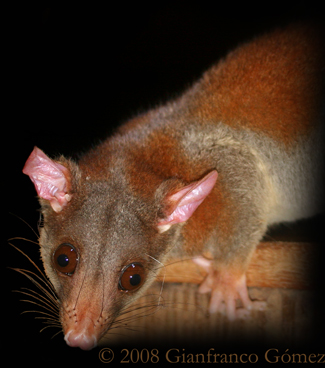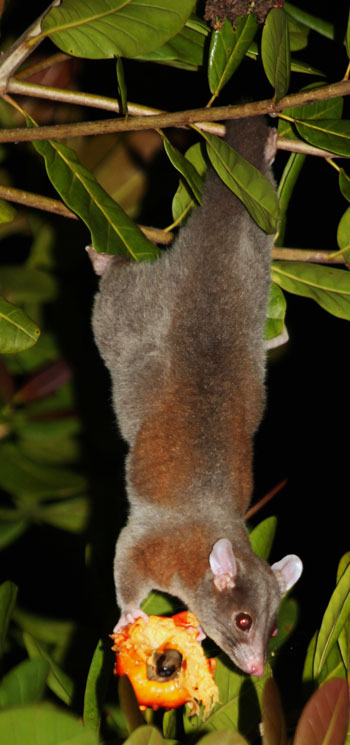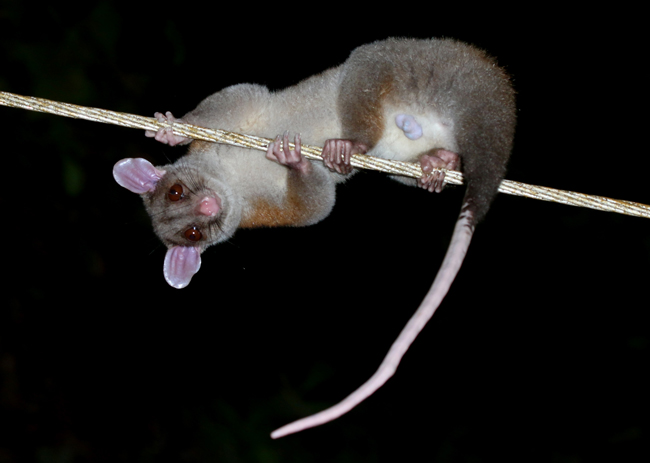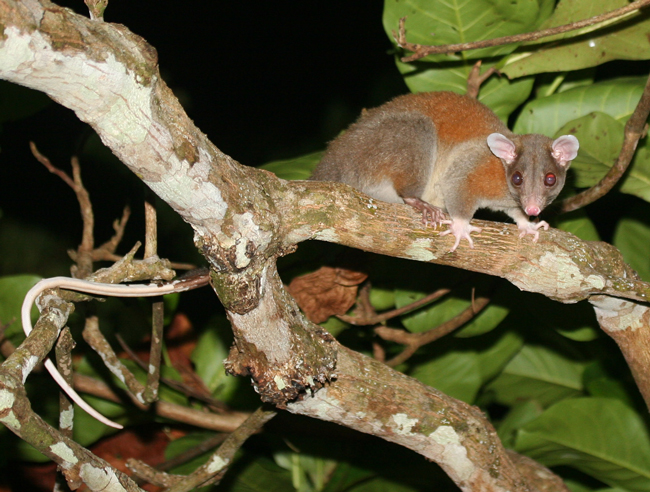|
 The
Central American Woolly Opossum is without a doubt one of the cutest
opossums in Drake Bay. They have a short nose, big ears
and large, engaging eyes. The
Central American Woolly Opossum is without a doubt one of the cutest
opossums in Drake Bay. They have a short nose, big ears
and large, engaging eyes.
Their fur is gray with rusty red
highlights and they have a long, naked, prehensile tail. The name of
their genus, Caluromys, translates to "Beautiful Mouse" in
Greek.
Woolly Opossum are the most arboreal opossums in Costa Rica and they
move through the trees with great agility and grace. In the years of
doing the Night Tour we have very seldom seen one on the ground.
They are
nocturnal and spend the days sleeping in their daytime retreat.
Although we sometimes see them on moonlit nights, they usually
prefer only the darkest nights for foraging.
It was a Woolly Opossum that gave us a surprise one night as we
returned home from a Night Tour. We were still building our house,
and had an old, creaky, wobbly, wooden ladder that we used to get to our room on the
second floor.
 As we approached, we saw what we thought to be one of
our cats resting on the ladder. Suddenly, I looked up and saw our
two cats peering down over the edge of the second level at the
very same animal resting on the ladder that we were looking at! We
had walked right into a stare down between our two cats and a
Central American Woolly Opossum....INSIDE OUR HOUSE! As we approached, we saw what we thought to be one of
our cats resting on the ladder. Suddenly, I looked up and saw our
two cats peering down over the edge of the second level at the
very same animal resting on the ladder that we were looking at! We
had walked right into a stare down between our two cats and a
Central American Woolly Opossum....INSIDE OUR HOUSE!
We
entered our house as quietly as possible, concerned the situation
could get crazy very quickly. Luckily, the opossum and the cats held
their ground even as we approached them.
After
snapping a few photographs, the first photo featured on this page is
one of them, we managed to get the opossum to climb on
a broom stick and carried him outside.
Unlike the Virginia Opossum,
that ranges into North America, the Woolly Opossum does not play
dead when threatened. They are reputed to attack and bite when
cornered!
Fortunately for everyone involved, there was an all around peaceful
outcome to the tense stand-off.
Central American Woolly
Opossums inhabit lowland rainforests as well as those in higher
elevations. Very little is known about their behavior in the wild.
Although no in-depth studies have been done on their diets,
scientists think they are probably omnivores. We often encounter
these animals drinking nectar from Balsa Tree flowers or feeding on
Mangos, Malay Apples, Cashew Apples and the stringy fruit of the
Cecropia Tree. They have also been documented eating large moths
which they snatch right out of midair.
 |



 Alien Earthlings
Alien Earthlings  The
Dark Side
The
Dark Side






 As we approached, we saw what we thought to be one of
our cats resting on the ladder. Suddenly, I looked up and saw our
two cats peering down over the edge of the second level at the
very same animal resting on the ladder that we were looking at! We
had walked right into a stare down between our two cats and a
Central American Woolly Opossum....INSIDE OUR HOUSE!
As we approached, we saw what we thought to be one of
our cats resting on the ladder. Suddenly, I looked up and saw our
two cats peering down over the edge of the second level at the
very same animal resting on the ladder that we were looking at! We
had walked right into a stare down between our two cats and a
Central American Woolly Opossum....INSIDE OUR HOUSE!












